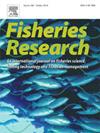Cumulative selectivity benefits of increasing codend and lifting-bag mesh sizes in an Australian whiting (Sillago spp.) boat seine
IF 2.3
2区 农林科学
Q2 FISHERIES
引用次数: 0
Abstract
Benthic boat seines (i.e. ‘Danish’ and ‘Scottish’ seining) are globally used to harvest inshore schooling species, however compared to other towed gears such as otter trawls, there have been few studies assessing factors affecting selectivity. Here the importance of ‘lifting-bag’ (a protective bag over the codend) mesh size was investigated as part of a broader initiative to determine suitability for harvesting adult (≥17 cm total length; TL) whiting (Sillago robusta and S. flindersi) under quota in New South Wales, Australia. Two codends made with either 37 or 45 mm stretched mesh openings (SMO) and representing the ranges within many existing Australian configurations were covered with either a conventional (91-mm SMO) or new (216 mm SMO) lifting bag and assessed during three experiments targeting 156 t of quota over 27 days (133 deployments). In experiment 1, alternately fishing the 37-mm codend with each lifting bag did not significantly affect seine selectivity. In experiment 2, the 37- and 45-mm codends with the 91-mm lifting bag were compared and there was a significant increase in the escape of small (<17 cm TL) S. robusta (but not S. flindersi which were caught across larger sizes) from the larger-meshed codend. Increasing the lifting-bag mesh size for the 45-mm codend in experiment 3 increased the escape of most sizes of S. robusta without affecting S. flindersi. The total discarded catch was 61 t and while some unwanted species also showed improved selectivity due to either the 45-mm codend (experiment 2) or increasing its lifting-bag mesh size (experiment 3), there were no significant effects. While the whiting catches (∼1.2 t deployment–1) and low discarding (28 %) recorded here support assertions of boat-seine efficiency, divergent morphology and/or depth-dependant distributions between S. robusta and S. flindersi may preclude optimising selectivity for both in the same seine. Nevertheless, codend and lifting-bag SMOs approaching ∼43 and 216 mm, respectively should allow some juvenile conspecifics to escape while maintaining targeted catches.
增加尾网和吊袋网尺寸的累积选择性效益在澳大利亚白衣(西拉斯戈)渔船围网
底栖生物渔船围网(即“丹麦”和“苏格兰”围网)在全球范围内用于捕捞近海繁殖物种,但与其他拖网(如水獭拖网)相比,很少有研究评估影响选择性的因素。在这里,作为一项更广泛的倡议的一部分,研究了“吊袋”(在尾端上的保护袋)网孔大小的重要性,以确定在澳大利亚新南威尔士州的配额下捕捞成鱼(总长度≥17 cm; TL)(西拉戈罗布斯塔和S.弗林德西)的适用性。采用37或45 毫米拉伸网孔(SMO)制作的两个终端,代表了许多现有澳大利亚配置的范围,使用传统(91毫米SMO)或新型(216 毫米SMO)举升袋进行覆盖,并在三次实验中进行评估,目标是27天(133次部署)的156 吨配额。在实验1中,每个吊袋交替捕捞37-mm尾鱼对围网选择性没有显著影响。在试验2中,比较了使用91 mm吊袋的37 mm和45 mm种子,发现小的(<17 cm TL) robusta(但没有捕获较大尺寸的flindersi)从大网目种子中逃脱的数量显著增加。在试验3中,增大吊袋孔大小可增加大部分大小的罗布斯塔的逃逸,但不影响弗林德斯。丢弃的总渔获量为61 t,虽然一些不需要的物种也由于45毫米的尾端(实验2)或增加其吊袋网目尺寸(实验3)而表现出改善的选择性,但没有显着影响。虽然这里记录的白渔获量(约1.2 t部署- 1)和低丢弃量(28% %)支持渔船围网效率的主张,但罗布斯塔和弗林德斯鲷之间形态和/或深度相关分布的差异可能会妨碍在同一围网中对两者的选择性进行优化。尽管如此,coend和liftbag SMOs分别接近~ 43和216 mm,应该允许一些同种幼鱼在保持目标捕获的同时逃脱。
本文章由计算机程序翻译,如有差异,请以英文原文为准。
求助全文
约1分钟内获得全文
求助全文
来源期刊

Fisheries Research
农林科学-渔业
CiteScore
4.50
自引率
16.70%
发文量
294
审稿时长
15 weeks
期刊介绍:
This journal provides an international forum for the publication of papers in the areas of fisheries science, fishing technology, fisheries management and relevant socio-economics. The scope covers fisheries in salt, brackish and freshwater systems, and all aspects of associated ecology, environmental aspects of fisheries, and economics. Both theoretical and practical papers are acceptable, including laboratory and field experimental studies relevant to fisheries. Papers on the conservation of exploitable living resources are welcome. Review and Viewpoint articles are also published. As the specified areas inevitably impinge on and interrelate with each other, the approach of the journal is multidisciplinary, and authors are encouraged to emphasise the relevance of their own work to that of other disciplines. The journal is intended for fisheries scientists, biological oceanographers, gear technologists, economists, managers, administrators, policy makers and legislators.
 求助内容:
求助内容: 应助结果提醒方式:
应助结果提醒方式:


